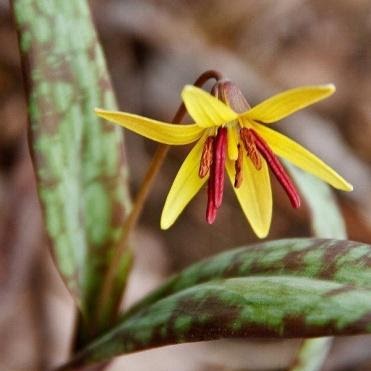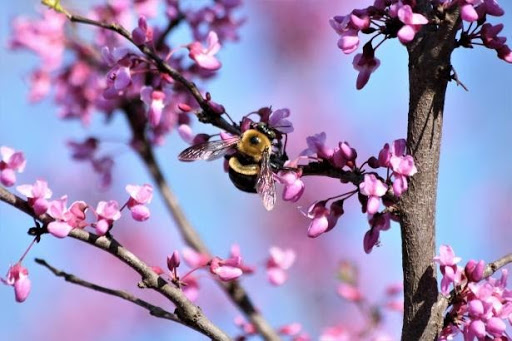It’s been a long, cold winter and we are all aching for warmer, sunnier days that bring on early spring flowers. And we’re not alone, early emerging bees, beetles, flies, moths and butterflies will be seeking the essential nectar and pollen from these early flowers.
I learned the importance of native plants and their vital role in our eco-systems while working at Project Native in Housatonic, MA. Until then, I never really gave natives a second thought. While working there as the Propagator and Seed Bank Manager, I began to realize the true importance of the native plants and their relationship to maintaining a healthy ecosystem. I observed hundreds of pollinators swarming the blossoms in the meadow, seed banks and gardens that were on the property. These pollinators were also food for the birds that relied on these insects to feed their young.
For example, a single pair of breeding chickadees must find 6,000 to 9,000 caterpillars to rear one clutch of young, according to Doug Tallamy, a professor of entomology and wildlife ecology at the University of Delaware. Although seeds are a nutritious winter staple, insects are best for feeding growing fledglings. Protein packed insects is the choice of 96% of North American land birds feeding their young.
We’re going to take a look at a few examples of native spring flowering species that not only gives us joy but essential to supporting our eco-systems.

One of the first native species that I personally connect with is Arisaema triphyllum (Jack-in-the-Pulpit). I remember spotting this unique spring woodland species as a young child at my grandmother’s home in Columbia County, NY. I do believe this was the beginning of my interest in horticulture. Jack-in-the-Pulpit is pollinated by flies which are attracted by a funky odor from the spathe (aka The Pulpit). After pollination, the plant’s flower produces a large clump of bright red berries in the late summer. These berries are eaten by birds and other small animals, which then spread the seeds after digesting.
Another early species is the Erythronium americanum (Trout Lily). Beautiful, yellow flowers with mottled green and burgundy leaves support the Andrena miner bee family. These bees are important to the pollination of woodland and garden bulbs, berries, and flowering trees and shrubs. Andrena erythronii, specializes on Trout Lily as a food source to provide its brood cells for its larvae. Many Mining Bee species look very similar to each other, so sometimes the easiest way to tell them apart is by the plant on which they are foraging. This a good example on the importance of our native spring ephemerals and theirrole as the only food source for specific species of native pollinators.
I get excited when I see Caltha palustris (Marsh Marigold) blooming in and along the stream on our property. Seeing the bright yellow blossoms is a sure sign spring is here. Growing up to 1.5’ high and wide this beautiful native is deer resistant. If you have a wet area with full to part sun in your yard, these low mounding perennials are ideal for these tough areas. The bright yellow blooms are nectar and pollen for bees and flies.
Aquilegia canadensis (Eastern R ed Columbine) appears in late spring with beautiful drooping bell-like red and yellow flowers that attract hummingbirds as
ed Columbine) appears in late spring with beautiful drooping bell-like red and yellow flowers that attract hummingbirds as
well as the Columbine Duskywing Butterfly. Growing up to 2’ tall Eastern Red Columbine prefers rich, moist, soil with light to moderate shade. I like to see this native species planted en masse. Planting en masse not only is impressive to us but will lure more pollinators than a scattering of plants here and there.
Zizia aurea (Golden Alexander) has yellow, lacey flowers blooms May-June. Reaching 1.5-2’ in height, this native perennial is the host plant for the Black Swallowtail Butterfly and a pollinator plant for bees. This species is perfect for those who want a bee/butterfly garden.
Let’s turn our attention to spring blooming native trees and shrubs. These beneficial trees and shrubs are hosts to hundreds of pollinators.
One of my favorites is Lindera benzoin (Northern Spicebush). Tiny clusters of greenish-yellow apetalous blooms appear along the branches in early spring. The spicy fragrance attracts bees and flies for pollination. It is the host plant for the Spicebush Swallowtail Butterfly. The leaf-rolling caterpillars are quite possibly the cutest of all caterpillars. The red drupes produced on the female shrubs are enjoyed by birds and small animals.

Cercis canadensis (Eastern Redbud) is a wonderful pollinator. Growing up to 30’ tall, this native tree blooms from April until May, this native tree is one of the earliest pollinator species. The purplish-pink flower clusters appears before the leaves and are crucial to native long-tongued bees. Other bees that visit these flowers include honeybees, bumblebees, mason bees, cuckoo bees, long-horned bees, mining bees, and sweat bees. Redbuds are also host plants for the larvae of several butterflies and moths. The flat, seed pods that ripen in the fall are food for squirrels and some birds.
Then, there is Amelanchier canadenis (Shadbush). This small tree grows up to 20’ in height and 10’ wide. This understory tree has white flowers in early spring, attracting bees and other pollinators. Purple berries
will ripen in early summer and are an important food source to nesting birds feeding their young. This native tree is ideal for mixed borders where height is desired.
We can all do our part to preserve our native species by introducing them into our landscapes. Planting native trees, perennials and grasses will provide essential food and habitat for many birds and animals.
Practicing organic growing methods is also very important. Harmful pesticides and herbicides have had a huge impact on beneficial pollinators and their habitats. Consider leaving the dandelions, clover and thyme to flower in your yard. These are important nectar sources for bees and other pollinators. You would be amazed by the number of pollinators that visit your yard and garden.


